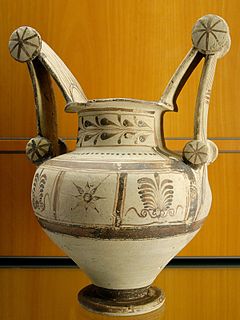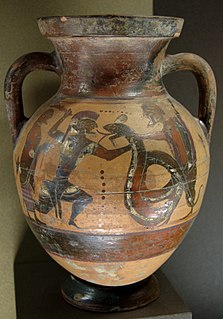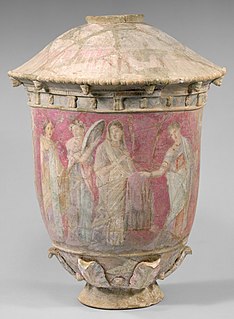External links
![]() Media related to Peucetian pottery at Wikimedia Commons
Media related to Peucetian pottery at Wikimedia Commons
Peucetii pottery was a type of pottery made in the Apulian region of southern Italy by the Peucetians from the beginning of the 7th to the 6th centuries BC. It is an indigenous type. Its production area occupied the space between Bari and Gnathia. The pottery was painted only in brown and black and was characterized by geometrical ornaments, swastikas, diamonds, and horizontal and vertical lines. [1] These samples were mainly in the Late Geometric phase of ceramics (before 600 BC) with a close ornamental pattern. The second phase of the pottery since the 6th century BC is influenced strongly by the Corinthian vase painting. [2] This is reflected both in the ornaments, decorations in the form of radiation, as well as a change to figurative representation. The third and final phase brings a shift in production methods. The pottery was hand-formed before the arrival of the Greeks in the southernmost tip of Italy, when the potter's wheel was introduced. The painting became purely ornamental. Shown on them are decorative plants like ivy and laurel vines and palmettes. Rare images included figurative and mythological figures.
![]() Media related to Peucetian pottery at Wikimedia Commons
Media related to Peucetian pottery at Wikimedia Commons

Ancient Greek pottery, due to its relative durability, comprises a large part of the archaeological record of ancient Greece, and since there is so much of it, it has exerted a disproportionately large influence on our understanding of Greek society. The shards of pots discarded or buried in the 1st millennium BC are still the best guide available to understand the customary life and mind of the ancient Greeks. There were several vessels produced locally for everyday and kitchen use, yet finer pottery from regions such as Attica was imported by other civilizations throughout the Mediterranean, such as the Etruscans in Italy. There were a multitude of specific regional varieties, such as the South Italian ancient Greek pottery.

Black-figure pottery painting, also known as the black-figure style or black-figure ceramic, is one of the styles of painting on antique Greek vases. It was especially common between the 7th and 5th centuries BC, although there are specimens dating as late as the 2nd century BC. Stylistically it can be distinguished from the preceding orientalizing period and the subsequent red-figure pottery style.

Red-figure vase painting is one of the most important styles of figural Greek vase painting.

In architecture and decorative art, ornament is a decoration used to embellish parts of a building or object. Large figurative elements such as monumental sculpture and their equivalents in decorative art are excluded from the term; most ornaments do not include human figures, and if present they are small compared to the overall scale. Architectural ornament can be carved from stone, wood or precious metals, formed with plaster or clay, or painted or impressed onto a surface as applied ornament; in other applied arts the main material of the object, or a different one such as paint or vitreous enamel may be used.
The Iapygians or Apulians were an Indo-European speaking people, dwelling in an eponymous region of the southeastern Italian Peninsula named Iapygia between the beginning of the first millennium BC and the first century BC. They were divided into three tribes: the Daunians, Peucetians and Messapians. After their lands were gradually colonized by the Romans from the late 4th century onward and eventually annexed to the Roman Republic by the early 1st century BC, Iapygians were fully Latinized and assimilated into Roman culture.

In art and iconography, a motif is an element of an image. The term can be used both of figurative and narrative art, and ornament and geometrical art. A motif may be repeated in a pattern or design, often many times, or may just occur once in a work.

The scroll in art is an element of ornament and graphic design featuring spirals and rolling incomplete circle motifs, some of which resemble the edge-on view of a book or document in scroll form, though many types are plant-scrolls, which loosely represent plant forms such as vines, with leaves or flowers attached. Scrollwork is a term for some forms of decoration dominated by spiralling scrolls, today used in popular language for two-dimensional decorative flourishes and arabesques of all kinds, especially those with circular or spiralling shapes.

The Pompeian Styles are four periods which are distinguished in ancient Roman mural painting. They were originally delineated and described by the German archaeologist August Mau (1840–1909) from the excavation of wall paintings at Pompeii, which is one of the largest group of surviving examples of Roman frescoes.
Geometric art is a phase of Greek art, characterized largely by geometric motifs in vase painting, that flourished towards the end of the Greek Dark Ages, c. 900–700 BC. Its center was in Athens, and from there the style spread among the trading cities of the Aegean. The Greek Dark Ages lasted from c. 1100 to 750 BC and include two periods, the Protogeometric period and the Geometric period, in reference to the characteristic pottery style. The vases had various uses or purposes within Greek society, including, but not limited to, funerary vases and symposium vases.

In the Archaic phase of ancient Greek art, the Orientalizing period or Orientalizing revolution is the cultural and art historical period that began during the later part of the 8th century BC, when there was a heavy influence from the more advanced art of the Eastern Mediterranean and the Ancient Near East. The main sources were Syria and Assyria, and to a lesser extent also Phoenicia and Egypt. With the spread of Phoenician civilization by Carthage and Greek colonisation into the Western Mediterranean, these artistic trends also influenced the Etruscans and early Ancient Romans in the Italian peninsula.

Etruscan art was produced by the Etruscan civilization in central Italy between the 10th and 1st centuries BC. From around 750 BC it was heavily influenced by Greek art, which was imported by the Etruscans, but always retained distinct characteristics. Particularly strong in this tradition were figurative sculpture in terracotta, wall-painting and metalworking especially in bronze. Jewellery and engraved gems of high quality were produced.

Apulian vase painting was a regional style of South Italian vase painting from ancient Apulia. It comprises geometric pottery and red-figure pottery.

In the visual arts, interlace is a decorative element found in medieval art. In interlace, bands or portions of other motifs are looped, braided, and knotted in complex geometric patterns, often to fill a space. Interlacing is common in the Migration period art of Northern Europe, especially in the Insular art of Ireland and the British Isles and Norse art of the Early Middle Ages and in Islamic art.

Daunian pottery was produced in the Daunia, today's Italian provinces of Barletta and Foggia. It was created by the Daunians, a tribe of the Iapygian civilization who had come from Illyria.

Messapian pottery is a type of Messapian ceramic, produced between the 7th century BC until the 3rd century BC on the Italian region of southern Apulia. Messapian pottery was made by the Messapii, an ancient people inhabiting the heel of Italy since around 1000 BC, who migrated from Crete and Illyria. Messapian pottery consisted first primarily, with geometric patterns like circles, squares, diamonds, horizontal dash patterns, swastika and other similar motifs. Late through Greek influence the meander was added. From about the beginning of the 5th century BC again under Greek influence, with imports of Attic pottery, figurative decoration was added. In addition, leaf motifs, new elements such as ivy and other repertoire were included. Up to then only fragments of the pottery was decorated in contrast to the whole surface being decorated after the 5th century BC. In the fourth century BC, the artists came back again to geometric ornamentation, but by then the ceramics were almost completely under Greek influence.

Boeotian vase painting was a regional style of ancient Greek vase painting. Since the Geometric period, and up to the 4th century BC, the region of Boeotia produced vases with ornamental and figural painted decoration, usually of lesser quality than the vase paintings from other areas.

Euboean vase painting was a regional style of ancient Greek vase painting, prevalent on the island of Euboea.
Cycladic vase painting was a regional style of Greek vase painting, produced in the Cycladic islands.

Centuripe ware, or East Sicilian polychrome ware, or the Centuripe Class of vase, is a type of polychrome Sicilian vase painting from the 3rd and 2nd centuries BC. It is rare, with only some 50 examples known. They have been described as "smothered in ornamental colors and shaped too elaborately", an example of Hellenistic "Middle-class taste [that] was often cloying and hideous, sometimes appealing."

Ancient Greek art stands out among that of other ancient cultures for its development of naturalistic but idealized depictions of the human body, in which largely nude male figures were generally the focus of innovation. The rate of stylistic development between about 750 and 300 BC was remarkable by ancient standards, and in surviving works is best seen in sculpture. There were important innovations in painting, which have to be essentially reconstructed due to the lack of original survivals of quality, other than the distinct field of painted pottery.